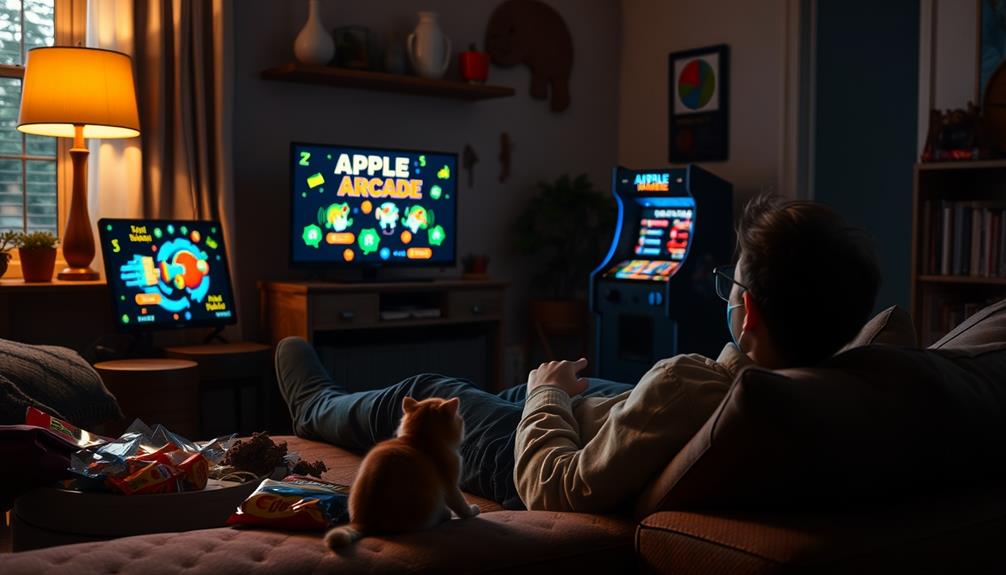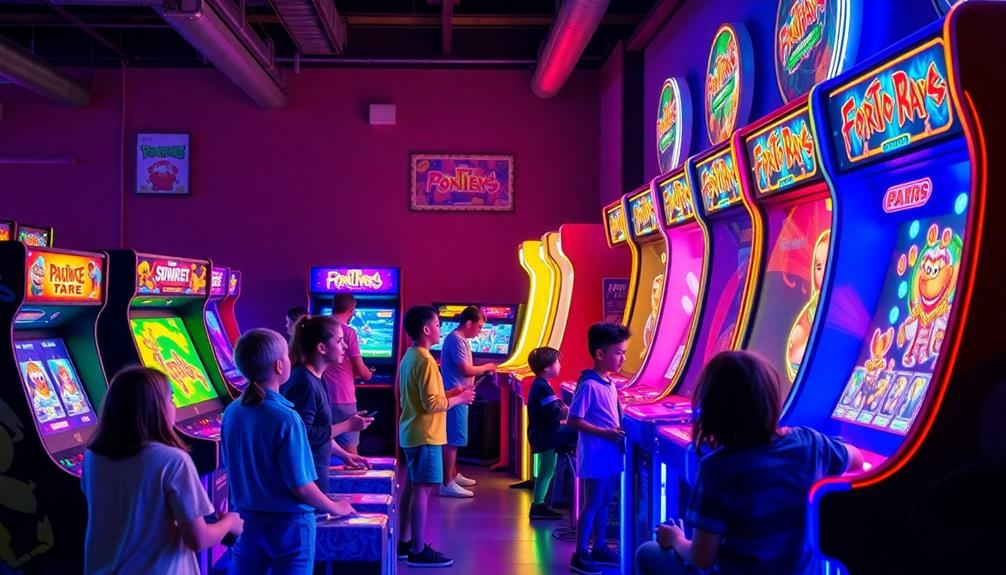In the 1980s, arcade games typically ranged in price from $2,000 to $4,000. The lower-end machines were priced around $2,000, while high-end models like Dragon’s Lair could cost up to $4,200 or even reach $20,000 for specialized setups. These prices were a reflection of the game’s innovation and popularity, as advancements in technology continuously transformed the arcade industry. Towards the end of the decade, many machines could be found with an average price in the thousands of dollars range. This shift in pricing not only impacted arcade venues but also influenced the home gaming market. Stay tuned for more intriguing details about arcade games from this unforgettable era!
Key Takeaways
- Arcade machines in the 1980s typically ranged from $2,000 to $4,000, with entry-level models starting around $2,000.
- High-end arcade machines, such as Dragon's Lair, could cost up to $20,000, reflecting advanced technology and design.
- The average cost for most machines during the decade settled between $3,000 and $4,000 by the end of the 1980s.
- Pac-Man was priced at approximately $2,400 in 1980, equivalent to $7,000 today.
- Coin-operated games usually charged between 25 cents and a dollar per play, influencing players' spending habits.
Overview of 1980s Arcade Games
In the vibrant world of the 1980s, arcade games became a cultural phenomenon that captivated players everywhere. You'd find yourself drawn to neon-lit arcades, where the sounds of beeping machines and cheering crowds filled the air. Iconic titles like Pac-Man, released in 1980, quickly grabbed your attention, offering thrilling gameplay for just a quarter. As you navigated mazes and gobbled pellets, you joined millions of others experiencing the excitement of arcade gaming.
The decade also saw the rise of innovative best arcade machines for home game rooms that made it possible for enthusiasts to bring the arcade experience home.
The decade saw a surge in diverse arcade games, with unique titles like Dragon's Lair and Street Fighter 2 providing fresh challenges. You could spend hours mastering combos or defeating high scores, contributing to the growing popularity of these machines.
By 1982, the thriving arcade scene had led to the sale of 400,000 units, showing just how much you and others embraced this new form of entertainment.
While the prices of arcade machines ranged widely, advancements in production techniques eventually made them more accessible. This evolution allowed more players to enjoy the thrilling world of arcade games, solidifying their place in the hearts of gamers and pop culture for years to come.
Average Costs of Arcade Machines
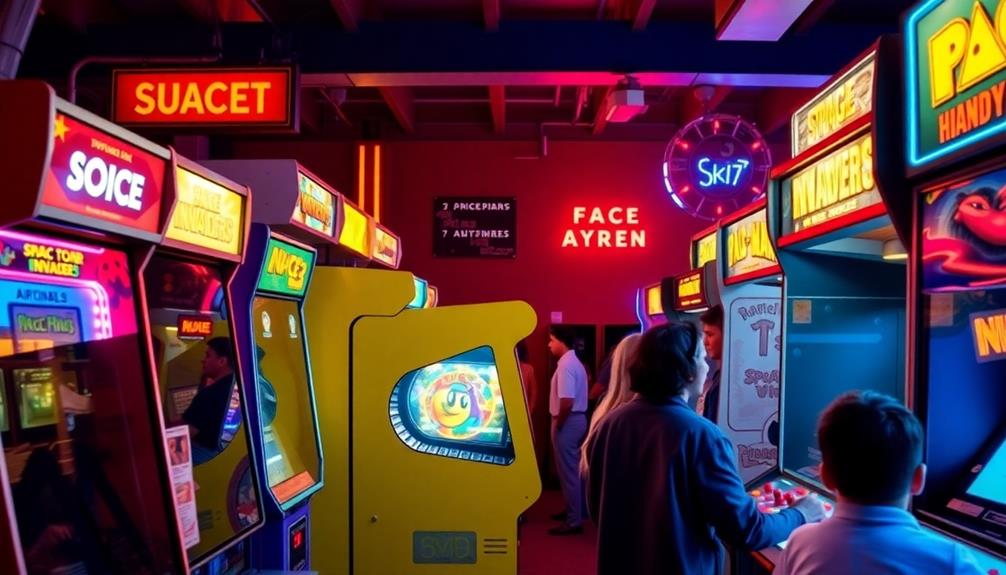
During the 1980s, you'd find arcade machines priced anywhere from $2,000 to $4,000, making them a significant investment for business owners. If you were looking to buy an arcade game, you'd need to weigh your options carefully. While entry-level machines could be found for around $2,000, more advanced units often reached up to $4,000.
As you explored the market, you'd notice a few high-end arcade machines priced as much as $20,000, which is equivalent to roughly $160,000 today! However, advancements in production led to a decrease in prices by the end of the decade, with typical arcade machines costing only a few thousand dollars.
Here's a quick overview of arcade machine costs in the 1980s:
| Type of Arcade Machine | Price Range | Notes |
|---|---|---|
| Low-End | $2,000 | Basic features |
| Mid-Range | $3,000 – $4,000 | Popular models |
| High-End | Up to $20,000 | Advanced technology |
| Typical by Decade End | A few thousand | Lower prices due to demand |
Understanding these costs can help you appreciate the arcade game landscape of that era.
High-End Machine Prices

When you look at high-end arcade machines from the 80s, you'll notice they came with premium price tags, often ranging from $3,000 to $20,000.
This variation in cost reflected not just the technology and gameplay experience but also the market demand at the time.
For instance, just like how essential oils for toothache relief offer targeted benefits, certain arcade games provided unique experiences that captivated players.
Understanding these factors helps explain why some machines became iconic, while others faded into obscurity.
Premium Gaming Experiences
Premium gaming experiences in the 1980s often came with a hefty price tag, reflecting the cutting-edge technology and design that defined this era of arcade gaming. If you wanted to play the latest video games, you'd need to shell out a significant amount—average arcade machines ran between $3,000 and $4,000.
However, some high-end machines could cost as much as $20,000, which is around $160,000 today. This era also mirrored the changing dynamics in entertainment, similar to how celebrity relationships evolved over time.
Notable titles like Dragon's Lair, priced at about $4,200, showcased advanced animation technology, despite mixed gameplay reviews. Similarly, Pac-Man, an iconic arcade staple, launched at approximately $2,400, equating to around $7,000 today.
The innovative Outrun in 1986 featured a unique driving experience, with machines costing between $3,500 and $5,000.
Multiplayer experiences also emerged, with games like Teenage Mutant Ninja Turtles released in 1989, typically priced around $4,000.
These premium gaming experiences not only drew players in with their visuals and gameplay but also represented a significant investment for arcade owners, highlighting the evolving landscape of video games during this dynamic decade.
Price Variations Explained
While high-end arcade machines in the 1980s offered cutting-edge experiences, their prices often reflected the technology and features they boasted. These machines could cost as much as $20,000, which is roughly $160,000 today. This steep price tag was primarily reserved for games that pushed the boundaries of innovation.
For example, "Dragon's Lair," with its advanced animation technology, came in at around $4,200, making it a premium choice for arcade operators. Additionally, the allure of unique experiences mirrored the appeal of top hotels with water parks that attract families seeking entertainment.
Most arcade machines, however, generally ranged between $3,000 and $4,000 during this decade. Specialized machines, like driving simulators, also commanded higher prices, often falling between $3,500 and $5,000, depending on their features.
As the decade progressed and production techniques improved, you'd find that the prices for arcade games typically decreased, enabling more operators to invest in these popular attractions.
Ultimately, the high-end prices reflected the unique experiences these games offered, appealing to both operators and players enthusiastic for the latest gaming technology. In a competitive market, these machines stood out, justifying their hefty price tags.
Market Demand Influence
The demand for high-end arcade machines in the 1980s considerably influenced their pricing, highlighting the importance of content relevance and authority in driving consumer interest.
Operators were willing to pay top dollar for machines that offered unique gameplay experiences, driving prices up to as much as $20,000—equivalent to about $160,000 today! While most arcade games averaged between $3,000 and $4,000, the allure of high-end titles was undeniable.
Here are three key factors that played into the pricing of these high-end machines:
- Unique Technology: Games like Dragon's Lair, priced at around $4,200, featured groundbreaking animation technology that set them apart from standard games.
- Revenue Potential: Successful titles like Pac-Man, which cost about $2,400, generated significant revenue, making them a justifiable investment for arcade operators.
- Market Trends: As production techniques improved, the overall price of arcade machines gradually decreased, allowing more operators to enter the market.
In a competitive landscape, the demand for high-end games shaped the pricing strategy, ensuring operators could maximize their investment while attracting enthusiastic gamers.
Price Trends Over the Decade
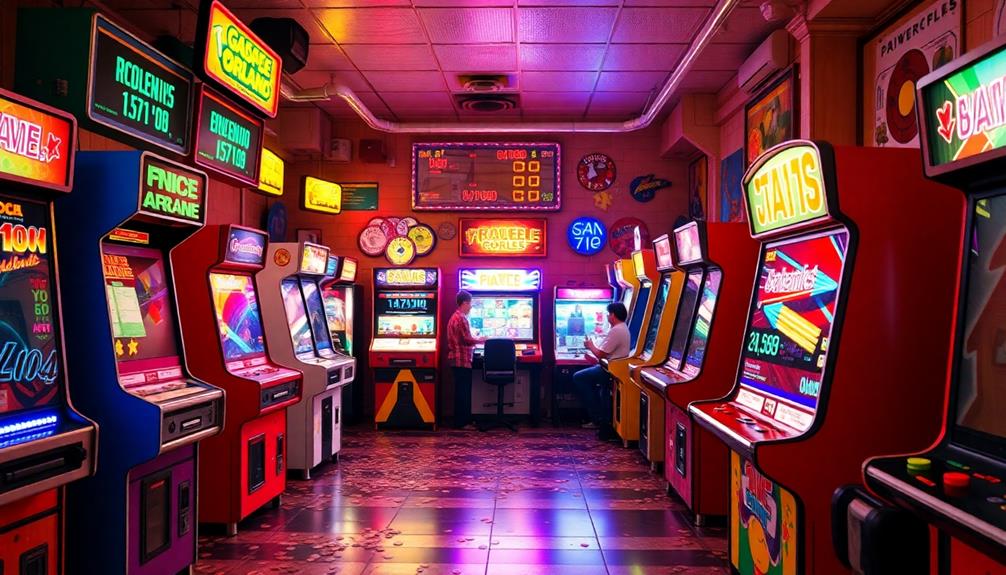
Observing the arcade game market in the 1980s reveals significant price trends influenced by demand and technology. At the start of the decade, the average cost of arcade machines ranged from $3,000 to $4,000.
As production techniques improved, prices started to decrease, opening up opportunities for smaller venues. You'd find lower-end arcade machines available for around $2,000, making it easier for operators to enter the market. The competitive pricing in the arcade sector parallels the transparent fee structures offered by companies in the precious metals market, providing an accessible entry point for new investors.
High-end machines, however, could soar to prices as high as $20,000, showcasing advanced features that appealed to avid gamers. For instance, a version of the game like Pac-Man was priced at approximately $2,400 in 1980, which translates to about $7,000 today. This significant commercial value illustrated how much players were willing to pay for an engaging gaming experience.
Throughout the decade, the combination of rising demand and technological advancements reshaped the landscape of arcade gaming. By the late '80s, you could see a broader range of prices, reflecting the diversity of games available, from budget-friendly options to premium machines with cutting-edge technology.
Notable Arcade Games and Costs
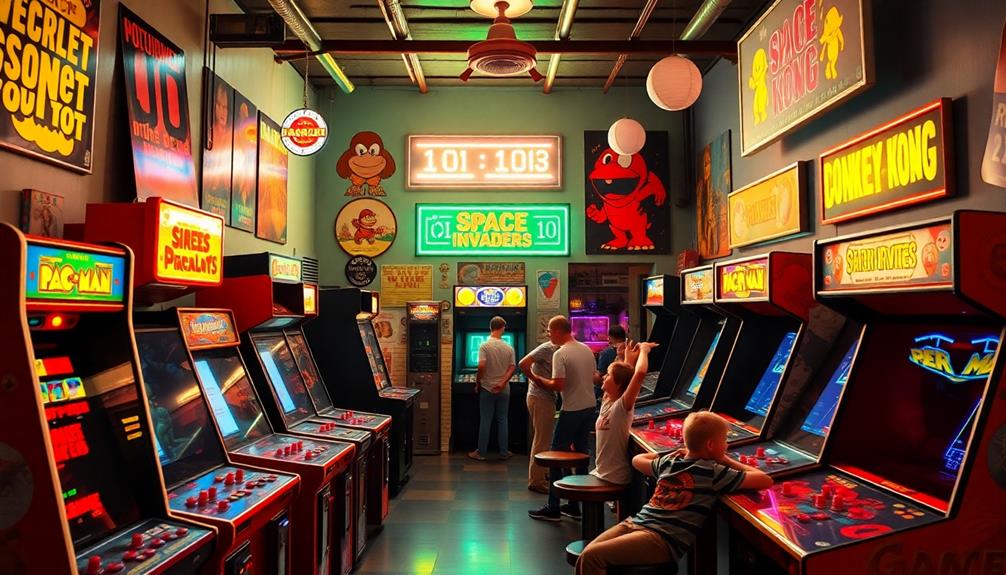
Arcade enthusiasts in the 1980s experienced a thrilling evolution in gaming, marked by iconic titles that not only captivated players but also varied considerably in cost. The prices of arcade machines reflected the innovation and popularity of the games they housed, leading to some fascinating choices.
This era wasn't only about gameplay but also about cultural impact, as games like Pac-Man influenced self-image and confidence, much like the astrological allure associated with different personality traits.
Here are three notable arcade games and their costs:
- Pac-Man (1980) – This beloved arcade version cost around $2,400, which would be about $7,000 today. It quickly became a top-seller, drawing crowds with its unique gameplay.
- Dragon's Lair (1983) – Known for its groundbreaking animation, this machine had a price tag of $4,200 but faced criticism for its challenging gameplay.
- Teenage Mutant Ninja Turtles (1989) – This four-player co-op game had a price tag of about $4,000, allowing friends to team up in the arcade.
These prices represent just a snapshot of the dynamic arcade scene, where players could immerse themselves in unforgettable experiences, each with its own price point, reflecting the growth of gaming during the decade.
Evolution of Coin-Operated Machines

Over the decades, coin-operated machines have evolved dramatically, transforming from simple mechanical devices into sophisticated video game systems that engage players' imaginations. Originally, in the 1920s, these machines served as fortune-tellers and music players, offering basic entertainment.
However, the 1970s marked a turning point with the rise of video game arcade machines, which quickly became the most popular form of coin-operated entertainment. Understanding the financial aspects of these machines, such as their investment costs, is essential for anyone looking to appreciate their historical significance.
By the 1980s, this evolution reached new heights. Notable titles like Pac-Man emerged, enthralling audiences and changing the gaming landscape forever. The prices of these arcade machines reflected their advancements, ranging from $2,000 to $4,000, with iconic games like Pac-Man costing around $2,400.
When adjusted for inflation, that's approximately $7,000 today. This shift from mechanical devices to complex video game systems not only enhanced gameplay but also laid the foundation for modern gaming culture.
As you stepped up to those brightly lit cabinets, you weren't just playing a game; you were part of a revolutionary experience that defined a generation. The evolution of coin-operated machines has truly shaped the way you enjoy gaming today.
Economic Impact on Players
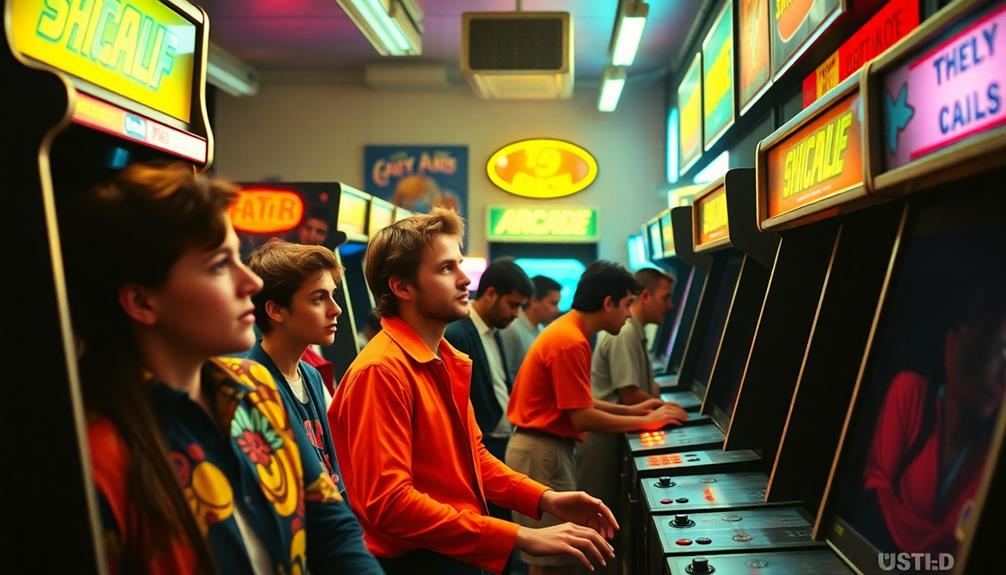
In the 80s, your disposable income played a huge role in how often you'd hit the arcade. As prices for games fluctuated, you likely noticed trends in your spending habits, from casually dropping quarters to becoming a dedicated player.
The economic conditions of the time, including inflation and changes in wages, influenced how much time and money players could devote to gaming, making it essential to contemplate the importance of selecting the right cold medication for effective relief.
Understanding these shifts can reveal a lot about the economic landscape of that era and its impact on your gaming experiences.
Disposable Income Influence
Leisure became an essential part of life in the 1980s, particularly for teenagers and young adults who flocked to arcades as a social hub.
With increased disposable income during this era, you and your friends could easily spend your weekends enjoying the latest games. The average cost of a game coin was around 25 cents, so budgeting for arcade visits became a routine.
The rise of arcade culture coincided with a growing interest in young tennis prodigies, showcasing how youth engagement in various activities flourished during this time.
Here are three ways disposable income influenced your arcade experience:
- Frequent Visits: With a bit of extra cash, you could visit arcades more often, turning gameplay into a regular social activity.
- Extended Playtime: Higher disposable income meant you could afford to spend multiple quarters at a time, diving deeper into games and enjoying longer sessions.
- Socializing: The arcade served as a gathering place, where you could connect with friends and meet new people, making the cost worthwhile.
While the initial investment for arcade owners was significant, the rising disposable income led to a boom in the arcade industry.
For many, the social and entertainment value of arcade games justified the expense, turning them into beloved pastimes.
Coin-Op Spending Trends
During the 1980s, the arcade scene was heavily influenced by coin-op spending trends that shaped how you and your peers interacted with games. The average cost of arcade machines ranged from $3,000 to $4,000, which meant operators had to balance their investments against pricing strategies. When a new game was released, it often cost you between 25 cents and a dollar to play, directly impacting how frequently you could indulge in gaming.
The high-end machines, priced up to $20,000, equated to around $160,000 today, showcasing the potential earnings from popular titles. For instance, by the end of the decade, Pac-Man alone generated between $3.5 billion and $6 billion, highlighting the economic impact of your spending.
As production technologies advanced, the prices of arcade machines began to drop, making it easier for more operators to enter the market. This increased availability meant you'd have more options, encouraging you to spend more time—and money—on your favorite games.
Ultimately, these spending trends reflected not just your dedication to gaming, but also the arcade industry's growth and sustainability during that vibrant decade.
Influence on Home Gaming Consoles
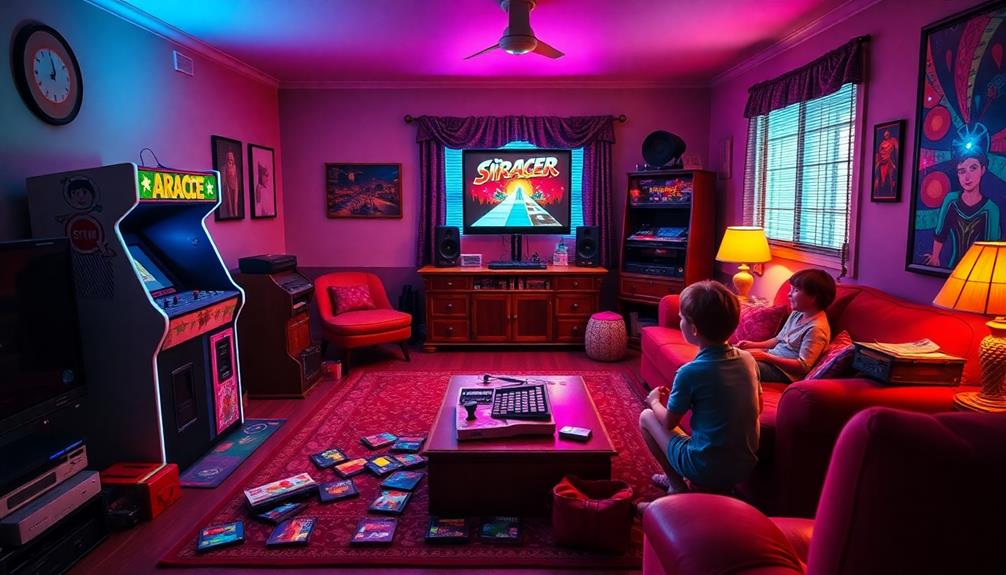
The arcade games of the 1980s, like Pac-Man, didn't just dominate the gaming scene; they also laid the groundwork for home gaming consoles. As players flocked to arcades, the demand for engaging gameplay experiences became clear, pushing home console manufacturers to adapt.
Here are three key influences from the arcade era:
- Adaptation of Popular Titles: Games like Pac-Man sold over 8 million copies on the Atari 2600, proving that arcade hits could translate to home systems and reach a wider audience.
- Enhanced Gameplay Features: The character-driven narratives and unique mechanics in arcade games set expectations for home consoles, encouraging developers to create more immersive video experiences.
- Hardware Improvements: The push for high-quality graphics and sound in arcades motivated manufacturers to upgrade their consoles, ensuring they could meet player demands for a similar experience at home.
The financial success of arcade games, raking in billions, highlighted the gaming market's viability.
This success prompted investments in home systems aimed at replicating that thrilling arcade experience, forever changing how you enjoy video games.
Cultural Significance of Arcades
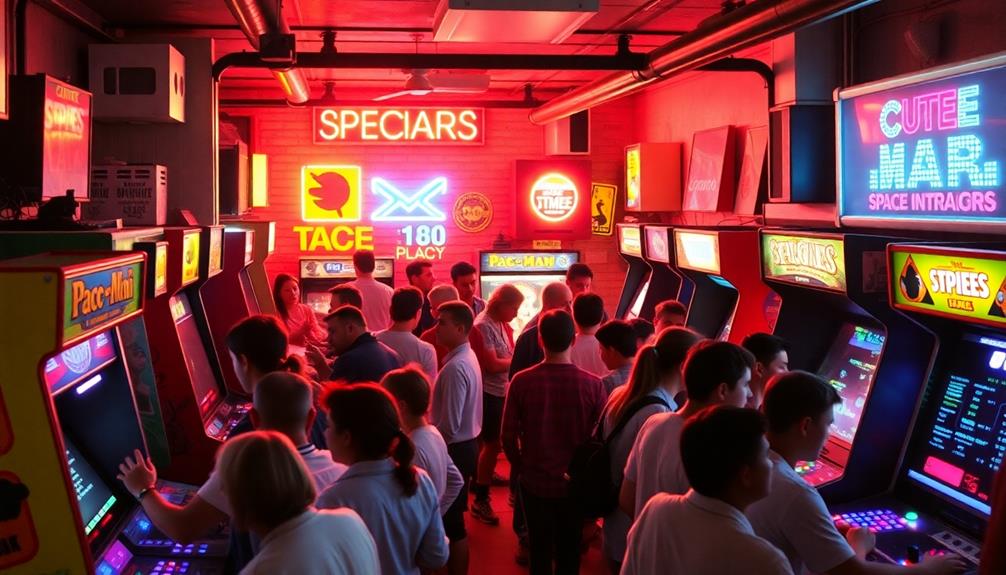
Arcades emerged as vibrant cultural hubs in the 1980s, drawing in a diverse range of players and creating a unique social atmosphere. With iconic games like Pac-Man, which was often affectionately referred to as "paku paku" due to its munching sound, arcades offered a communal space where friendships blossomed.
Players gathered to compete for high scores, share tips, and revel in the thrill of gameplay. The popularity of arcade games markedly influenced youth culture, making arcades synonymous with entertainment during that era. You could often find groups huddled around machines, cheering each other on or exchanging strategies.
This camaraderie fostered a sense of belonging, turning casual gamers into a tight-knit community. As you navigated through the bright and colorful designs of various arcade machines, you became part of a larger movement that contributed to the booming video game industry.
The revenue generated helped pave the way for the home console systems we enjoy today. Ultimately, the cultural significance of arcades in the 80s lies in their role as gathering spots that shaped social interactions and left a lasting impact on gaming culture.
Legacy of 80s Arcade Games

From the moment you stepped into a neon-lit arcade in the 80s, you were experiencing a cultural revolution in gaming that still resonates today.
These games didn't just entertain; they paved the way for the gaming industry as we understand it. The legacy of 80s arcade games is profound, influencing many aspects of modern gaming.
Here are three key points to reflect on:
- Revenue Generation: Titles like Pac-Man and Donkey Kong didn't just capture attention; they generated billions in revenue, establishing gaming as a viable business.
- Cultural Impact: These games transformed gaming into a popular cultural phenomenon, leading to sequels, merchandise, and media adaptations that keep the spirit alive.
- Inspiration for Today: Many modern games draw inspiration from these classics. You'll often find re-releases of first video games on current platforms, reflecting their enduring appeal.
The 80s arcade boom set the stage for today's gaming landscape, proving that the joy of a simple joystick and pixelated graphics can echo through generations.
The influence of that era continues to shape how you play and enjoy games today.
Frequently Asked Questions
How Much Were Arcade Games in the 80S?
In the 80s, arcade games typically cost between $2,000 and $4,000. You'd find popular titles like Pac-Man priced around $2,400, while high-end machines could reach up to $20,000, adjusting for inflation today. However, the cost of arcade games has significantly decreased in recent years with the rise of mobile and digital gaming. Now, many arcade games can be found for just a few hundred dollars or even less. This shift in pricing reflects the changing landscape of the gaming industry and the increased accessibility of gaming technology to a wider audience.
How Much Did Games Cost in the 1980S?
In the 1980s, video games typically cost between $30 to $60, depending on the platform. You'd find prices fluctuating as technology advanced, making some titles more accessible while premium games remained pricier.
What Was the First Arcade Game to Cost 50 Cents?
You'll be amazed to learn that "Dragon's Lair," released in 1983, was the first arcade game to cost 50 cents. Its stunning animation and laserdisc technology made it a groundbreaking experience you couldn't resist!
What Was the Biggest Arcade Game of 1980?
The biggest arcade game of 1980 was Pac-Man. You'd find it in almost every arcade, enchanting players with its unique gameplay and vibrant graphics. Its influence reshaped gaming culture and set new industry standards.
Conclusion
In the grand arcade of life, the 1980s were a vibrant era where games transformed not just entertainment, but culture itself. With costs that varied from a quarter to a few dollars, these machines became gateways to adventure and social connection. As you reflect on those pixelated journeys, remember how they paved the way for today's gaming landscape. The legacy of these arcade games continues to resonate, reminding us that play is a timeless part of our human experience.



